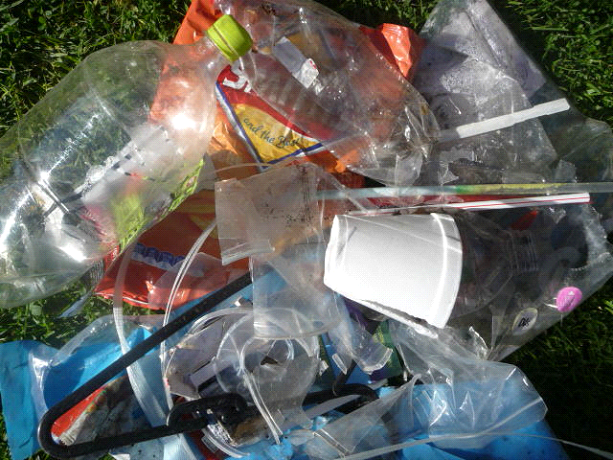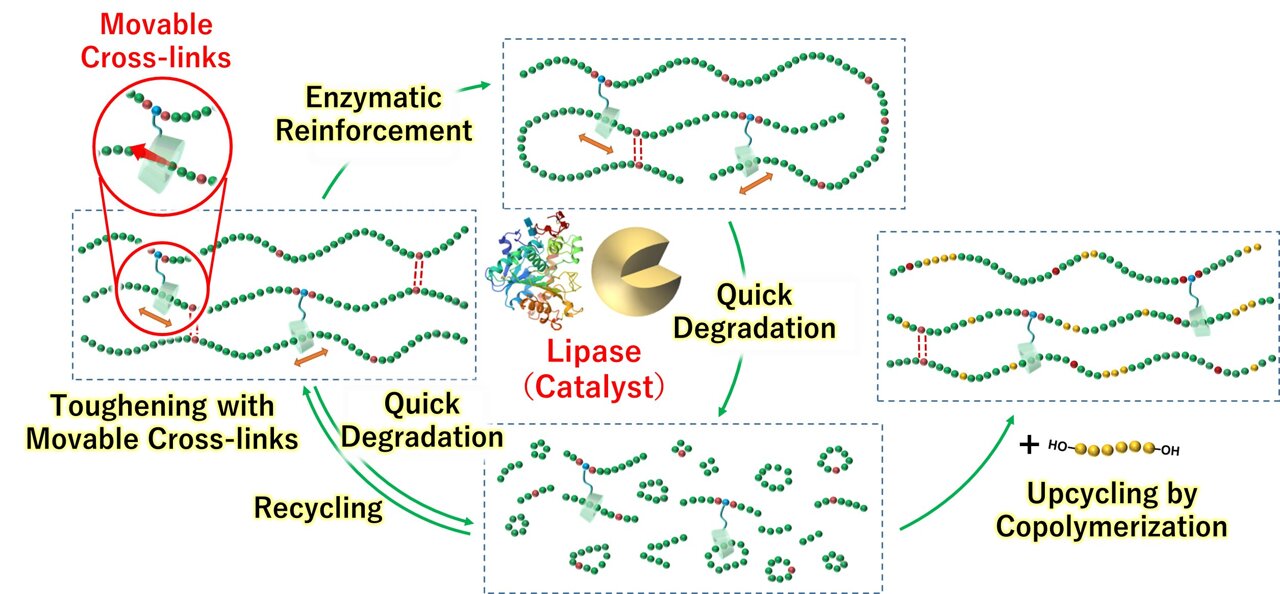
Advanced biodegradable plastics run rings around their predecessors – Japan
Posted on November 1, 2024 by DrRossH in Plastic Waste NewsSource: Advanced biodegradable plastics run rings around their predecessors
Plastics and polymers need to achieve both desirable performance in terms of durability and strength, as well as triggerable degradation capability to enable their breakdown into useful components for reuse. At present, there is a tradeoff between these factors; i.e., increased toughness makes the polymer more difficult to degrade. The researchers have used movable crosslinks to resolve this problem.
The movable crosslinks are ring-like cyclodextrins, which are threaded on one polymer strand and attached to another, endowing the resulting plastics with increased toughness and durability. Cyclodextrins are nontoxic, biodegradable, and widely available, making them attractive as a polymer component.
“Our polymer design using movable cyclodextrin crosslinks increased polymer toughness by over eight times,” says lead author of the study Jiaxiong Liu. “Stiffness, ductility, fracture stress, and fracture strain all improved because the cyclodextrin groups effectively dispersed local stress.”
The cyclodextrin crosslinks also facilitated degradation of the polymers during subsequent enzymatic treatment because their bulky structure increased the free volume in the polymer network, which improved access of the enzyme to the target cleavage sites on the polymer chains.
“The polymers were readily degraded by Novozym 435, an enzyme that specifically attacks the ester bonds of the polymer backbone,” explains Yoshinori Takashima, senior author. “The presence of the bulky cyclodextrin crosslink groups decreased entanglement and aggregation of the polymer chains, which facilitated the access of the enzyme to the ester bonds for cleavage.” As a result, biodegradability was improved by twenty times compared with that of the polymer without cyclodextrin groups.

 How many people today grab a takeaway coffee cup from the local cafe to drink on the go? We don’t know, but the number must be enormous.. Most every one of the above have a plastic top that will last 100s of years. Some cafes still use plastic cups that last a similar time. Is 10 minutes of coffee worth 100s of years of trash?
These items can be seen littering our gutters and on our streets all over the place. If they were all cardboard, they would still be littered, but they would, at least, be gone in a short time.
They do not need to be made of plastic.
How many people today grab a takeaway coffee cup from the local cafe to drink on the go? We don’t know, but the number must be enormous.. Most every one of the above have a plastic top that will last 100s of years. Some cafes still use plastic cups that last a similar time. Is 10 minutes of coffee worth 100s of years of trash?
These items can be seen littering our gutters and on our streets all over the place. If they were all cardboard, they would still be littered, but they would, at least, be gone in a short time.
They do not need to be made of plastic.
 On the way home from the gym last week, a distance of about 1 km (1/2 mile), I counted the items of plastic litter on the curb as I walked. In that short distance I counted 63 pieces of plastic litter. Plastic drink bottles, bottle tops, candy wrappers, plastic film, polystyrene fragments etc. That seemed to be a lot to me. I guess it is a generational thing. Our parents would have been horrified to see that amount, whereas it seems to go unnoticed by our youth of today. In another 20 years how many pieces will there be on this stretch, -- 200? What will today’s youth think of that new amount then when they are older? Will their children be so readily accepting of a higher amount of litter?
On the way home from the gym last week, a distance of about 1 km (1/2 mile), I counted the items of plastic litter on the curb as I walked. In that short distance I counted 63 pieces of plastic litter. Plastic drink bottles, bottle tops, candy wrappers, plastic film, polystyrene fragments etc. That seemed to be a lot to me. I guess it is a generational thing. Our parents would have been horrified to see that amount, whereas it seems to go unnoticed by our youth of today. In another 20 years how many pieces will there be on this stretch, -- 200? What will today’s youth think of that new amount then when they are older? Will their children be so readily accepting of a higher amount of litter? 
Discussion · No Comments
There are no responses to "Advanced biodegradable plastics run rings around their predecessors – Japan". Comments are closed for this post.Oops! Sorry, comments are closed at this time. Please try again later.